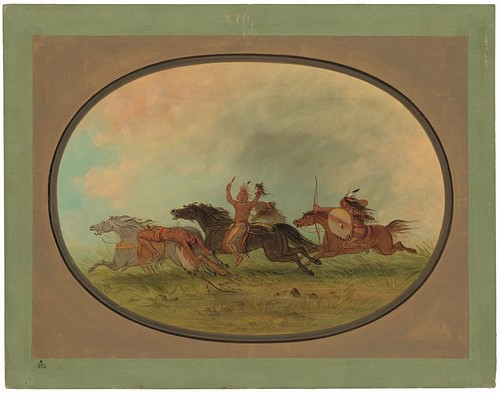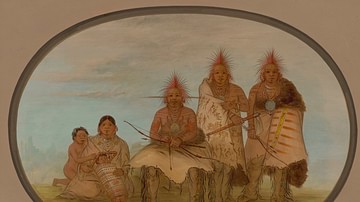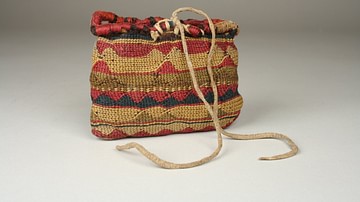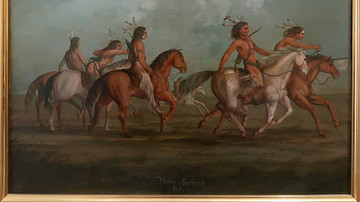A Storm Eagle is a Cheyenne story recounting a battle fought between the Cheyenne and Pawnee in the winter of 1854-1855 when the Cheyenne retrieved the horses that the Pawnee had stolen from the Arapaho, who were allies of the Cheyenne. The story is important as an account of Native American warfare.

There are many aspects of armed conflict between Native Peoples of North America illustrated in this story, including how war parties tracked their opponents, the command structure, weapons used (firearms, in this case), how battles were fought, and what they were frequently fought over, after the introduction of the horse and European weapons to the Plains Indians culture and, most importantly, the military practice of counting coup.
The title refers to the magical bundle containing a medicinally dressed eagle ("medicine" referring to supernatural powers) the Cheyenne find on a dead Pawnee warrior. This "storm eagle" is far from the focus of the piece, however, which instead addresses how a Cheyenne warrior conducts himself in battle and the redemptive aspect of counting coup. The mystical eagle, which brings storms when its wrappings are opened, represents the spiritual power of the Pawnee, claimed by the Cheyenne after the battle.
Commentary
Counting coup was a means of showing one's courage and skill in battle without having to kill an opponent. A warrior had to touch an enemy – using a weapon, one's hand, or the object known as the "coup stick" (a wooden rod, sometimes curved at the end, sometimes topped by a thick rawhide ball) – and then retreat unscathed, leaving the other alive. Successfully executed, this brought honor to the one who "counted coup" and dishonor to the one it was counted against. Once a warrior had been touched in this way, he was no longer considered a threat – as he could easily have been killed – and would sometimes withdraw from battle.
In this story, Sand Hill, Crazy Wolf, and Gentle Horse all count coup on a single Pawnee warrior – even though Crazy Wolf shies away at first – which would have brought great honor to them all. The inclusion of the detail of Crazy Wolf's initial reluctance but eventual success would have gone to show young men in the audience proper behavior in battle. Gentle Horse admonishes Crazy Wolf for cowardice and Crazy Wolf then corrects himself. Scholar Adele Nozedar describes the practice and how it was regarded as illustrated in A Storm Eagle:
Victory over an enemy was "certified" by the first touch of that enemy, be it with a stick, the hand, or a weapon, while he was still alive. This initial contact constituted the first "coup". If the enemy was subsequently killed after this touch, then this was the second coup. If the enemy was then scalped to boot, this counted as three coups. (117)
Counting coup might also serve as a means of redemption, as in this story where Eagle Feather – whose father had lost the sacred Four Arrows of the Cheyenne to the Pawnee – counts coup against the enemy and loses his life doing so. According to Nozedar (and others) the Four Arrows symbolized "the actual existence and soul of the Cheyenne Nation itself" (463) and so Eagle Feather's act of courage is understood as redemptive. At the end of the story, he is not mourned because, in successfully counting coup, he brought honor not only to himself but to his family.

Several details in the story place it after contact with the Euro-Americans besides the horse, which had been introduced to the Great Plains by c. 1700, such as the field glasses mentioned in relation to the scout New Dog and the use of firearms. Although the importance the piece places on counting coup is reminiscent of the Sioux tale, The Sioux who Married the Crow Chief's Daughter, it is significantly different in detailing how Native American warfare was waged, for what purposes, and how a warrior was expected to comport himself on the battlefield. The story is also important for non-Native audiences in dispelling the myth that Native Americans were all peace-loving nature-worshippers, lacking any knowledge of military tactics or formal combat.
Text
The following is taken from By Cheyenne Campfires (1926) by the anthropologist and historian George Bird Grinnell (l. 1849-1938) who is among the best-known writers to record Native American tales from the people themselves in an effort to preserve them.
One winter – 1854-1855 – seventy-five Cheyenne, led by Little Wolf and Lean Bear, went down the Arkansas River as far as the Pawnee Fork, and from there north to the Smoky Hill River. After they had reached it, New Dog went down the Smoky Hill River to see what he could discover. Buffalo were everywhere, as far as he could see, and all were feeding quietly except in one place where he saw the buffalo moving. He had no field glasses but could see something going toward the timber on the river.
When he returned to the camp, he told what he had seen, and Lean Bear came out from his war lodge and told the young men to saddle up and directed that what New Dog had seen should be cried out through the camp. They all made ready and set out, but it was late, nearly sundown, when they started for the place, and by the time they had reached there it was late at night and very dark, so they stopped and slept there.
Next morning at daylight, someone went a little way down the river and there found a fire still burning. Pawnee had stopped there with a herd of ponies that they had taken from the Arapaho on Crooked Creek south of the Arkansas River. They Cheyenne took the trail, which led north. After a time, however, they lost the trail, because the buffalo were all over the country and had run over it and trodden it out. The Cheyenne determined to go on north to the next river, thinking that there, on the sandbars, they would see the trail where they Pawnee had crossed. When they reached the river, it was nearly night. Some wanted to go down the river and some up. As they could not decide what to do, they stopped for the night on this stream, which the Cheyenne call Cedar River – the Saline River.
Very early in the morning, some started down the river and some up, to look for the trail of the Pawnee. Little Wolf went with the party which rode down the stream and Lean Bear went up the stream. Lean Bear's men found nothing and, at daylight, they went to the hills and the older men dismounted and sat down in a circle to smoke. The wind was blowing from the south and they sat with their backs to the south. The young men who did not smoke sat on their horses, leaning forward. Presently, those who were sitting on their horses heard someone singing. The sound came from the river and the south. The young men told those who were smoking that someone was singing, and all stopped to listen. The older men said: "Let no one move. Keep still." All kept still and sat there.
Those who were on horseback could see further than those on the ground, and presently they said that a man was coming, leading a horse. He was coming closer, still singing. He was singing a Pawnee song of thanksgiving. They sing this song when horses are given them as presents. To this day, when anyone gives them presents of horses, the Cheyenne and Arapaho too sing this song.
The Pawnee, when he saw horses standing there without riders, must have thought he was overtaking his party. The Cheyenne who were on horseback were leaning forward on their horses' necks and it may have looked to him as if these were all loose horses. When the Pawnee got close, he saw that the was walking up to his enemies. He had some buffalo meat on the horse he was leading, so he jumped off the one he was riding, threw the meat from the one he was leading, and mounted it. It was a spotted horse. They think that, if he had stayed on the horse he was riding, he might have gotten away, for that was a fast Arapaho horse, which the man had taken from the Arapaho on Crooked Creek. The Pawnee started back the way he had come, to get to the river, where there was much brush and sunflower weeds. The Cheyenne followed him.
When he crossed the stream, he left his horse and ran on foot so that he might hide, and the Cheyenne could not find him. They hunted for him in every direction. Three of them, Gentle Horse, Sand Hill, and Crazy Wolf, followed up a little stream to its head. Sand Hill had left them and had started across to look in another creek. Then Crazy Wolf shouted out, "There he is, in the weeds!" Gentle Horse said to Crazy Wolf, "You are young and have never counted a coup; rush on the Pawnee and touch him."
The enemy was still hidden in the weeds. Crazy Wolf charged on the Pawnee but, before he got near him, turned and ran back. Gentle Horse said to him, "You must not act in that way – like a coward." Gentle Horse went up alongside of Crazy Wolf and said to him, "Charge on him again." By this time, the Pawnee was on his feet with bow and arrow in his hand, and this time, again, Crazy Wolf turned off and did not go near the Pawnee.
Now, Sand Hill was seen coming up on his black horse, which was one of the fastest horses in the Cheyenne tribe. Sand Hill counted the first coup on the Pawnee, then Crazy Wolf, and Gentle Horse the third coup. He also shot him with a gun. Gentle Horse took the scalp and gave it to Lean Bear when he came up, for it was the custom to give a scalp to the one who carried the pipe.
When the shot sounded, all the other Cheyenne came running to this place. After a time, they all rode up on a hill to look for other enemies, when on another hill they saw Indians running toward the stream. Lean Bear cried out, "They have found the Pawnee," and all started for that creek. Lean Bear cautioned the young men, saying to them, "Go slowly, we will get there in time." When they rode up they saw three men sitting against a bank and before them stood some medicine men singing – doctoring them. These three had been wounded by Pawnee. The fight had been going on since early in the morning, but as the wind was blowing the other way, Lean Bear and his party could not hear the shots. Lean Bear cried out, telling his men to dismount and fight on foot. The Pawnee were in the stream bed and hidden among the dogwoods, so that the Cheyenne could not see them.
Lean Bear was an old brave man and had counted more coups than any of the Cheyenne. When he saw his men wounded, he growled like a bear and cried out to them to be brave and to fight carefully, as he had fought in many battles. Because of the brush at the forks of the stream where they were hiding, the Cheyenne could not see the Pawnee and could not tell how many there were in this party. Two Pawnee were shooting from the forks, and two other Pawnee were shooting from another place further up the stream. Lean Bear and Little Wolf told those of their men who had guns to fire at these two places. So they kept loading their guns and firing together at these places. After they had fired many shots at these points, the fire from the Pawnee ceased. They Cheyenne began to draw in closer but there were no more shots from the Pawnee.
Eagle Feather – the son of that Bull who had lost the medicine arrows when the Pawnee captured them – mounted his horse and said he intended to ride into the brush where the Pawnee were and everyone made ready to jump into the bushes as soon as Eagle Feather rode in. All the others were on foot, since they could run in better afoot. As soon as Eagle Feather rode into the brush, they all whooped and ran in after him. They heard a shot. Eagle Feather had ridden on a wounded Pawnee who had a gun in his hand and, as Eagle Feather struck him with the bowstring lance he was carrying, the Pawnee raised his gun and shot Eagle Feather between the eyes. Cheyenne on foot were coming behind Eagle Feather and they shot the Pawnee.
At the forks of the stream, Lean Bear rushed into the brush, his son following close behind him. He saw a dead Pawnee lying on the other side of the stream and told his son to count coup on him. Man Above and some other young men rushed forward to count coup. Little Wolf picked up the Pawnee's gun. Under the man, Lean Bear saw something and pulled it out. It was wrapped up in cloth and smelled like medicine roots. He carried it out and opened it. It was an eagle stuffed with all kinds of Pawnee medicine tied up in different pieces of buckskin. The Pawnee call the eagle a storm eagle.
When the Pawnee used to go out on the warpath to take horses, they took this eagle with them to cause a storm to come up when they were taking horses so that their trail would be washed out and could not be found. The Cheyenne found that this was true for, when Lean Bear opened this eagle after the fight, a big storm came up.
They counted nine dead Pawnee and found and counted ten buffalo robes, so one Pawnee must have escaped. They say that a warrior used to carry with him only a single buffalo robe, since two were too heavy a load to carry on foot.
When the party came in with these scalps, they did not mourn for Eagle Feather because he was killed while counting coup on his enemy. They brought the scalps in to Bent's Fort, on the Arkansas River, where the big village of Cheyenne was camped.










